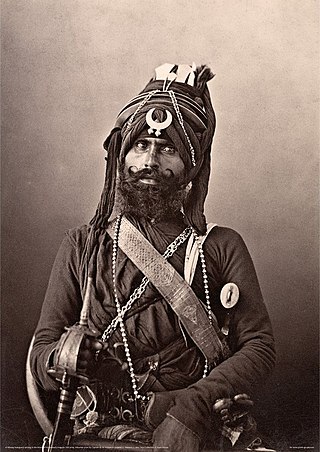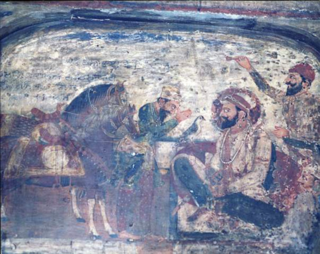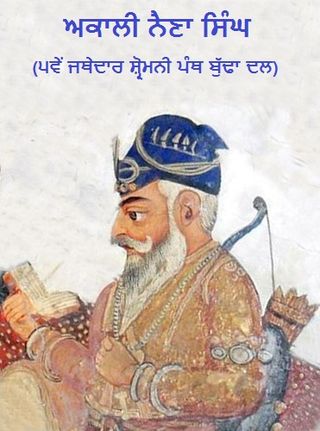Adherents of Sikhism follow a number of prohibitions. As with any followers of any faith or group, adherence varies by each individual.
The following outline is provides an overview of Sikhism, or Sikhi.

The Damdamī Ṭaksāl, also sometimes referred to as Giani Samparda, Jatha Bhindra(n), or Sampardai Bhindra(n) is an orthodox Sikh cultural and educational organization, based in India. They are known for their teachings of vidya as well as gurbani santhya. Its headquarters are located in the town of Mehta Chowk, approximately 40 km north of the city of Amritsar. It has been described as a seminary or “moving university” of the Sikh countryside.

The Nihang or Akali also known as Dal Khalsa is an armed Sikh warrior order originating in the Indian subcontinent. Nihangs are believed to have originated either from Fateh Singh and the attire he wore or from the "Akali" started by Guru Hargobind. Early Sikh military history was dominated by the Nihang, known for their victories where they were heavily outnumbered. Traditionally known for their bravery and ruthlessness in the battlefield, the Nihang once formed the irregular guerrilla squads of the armed forces of the Sikh Empire, the Sikh Khalsa Army.

The Akal Takht is one of five takhts of the Sikhs. It is located in the Darbar Sahib complex in Amritsar, Punjab, India. The Akal Takht was built by Shri Guru Hargobind Ji as a place of justice and consideration of temporal issues; the highest seat of earthly authority of the Khalsa and the place of the Jathedar, the highest spokesman of the Sikhs.

Fateh Singh, commonly referred to with honorifics as Baba Fateh Singh or Sahibzada Baba Fateh Singh, was the fourth and youngest son of Guru Gobind Singh.

A gyani or giani is an honorific Sikh title used by someone learned in Sikhism and who often leads the congregation in prayers, such as Ardas, or in singing (kirtan). The word gyan means "knowledge" in Punjabi, being a derivative of the Sanskrit word jnana. So a "gyani" is one who has spiritual and religious knowledge and can help the congregation—the Sadh Sangat—in understanding the Sacred Texts and the history of the religion.

Bidhi ChandChhina was a Sikh religious preacher and military commander, from Chhina Bidhi Chand village, 37 kilometers south of Amritsar and Chhina Bidhi Chand was part of Amritsar District not Lahore. His birth place temple is situated in his own village Chhina Bidhi Chand, which was built by the residents with the help of Baba Daya Singh. Baba Daya Singh laid foundation with his own hands. Every year on his birthday Baba Daya Singh, and now Baba Avtar Singh, would go to village Chhina Bidhi Chand and celebrate it there to date. He was a disciple of Guru Arjan and served Guru Hargobind for most of his life.

Akali Phula Singh Nihang was an Akali Nihang Sikh leader. He was a saint soldier of the Khalsa Shaheedan Misl and head of the Budha Dal in the early 19th century. He was also a senior general in the Sikh Khalsa Army and commander of the irregular Nihang of the army. He played a role in uniting Sikh misls in Amritsar. He was not afraid of the British who at many times ordered for his arrest but were not successful. During his later years he served for the Sikh Empire as a direct adviser to Maharaja Ranjit Singh. He remained an army general in many famous Sikh battles up until his martyrdom in the battle of Nowshera. He was admired by the local people and had a great influence over the land and his settlement was always open to help the poor and helpless. He was well known and was a humble unique leader and prestigious warrior with high character. He was also known for his effort to maintain the values of Gurmat and the Khalsa panth.

Chabhal Kalan is a town in the Tarn Taran district of Punjab, India and is located 13 miles (21 km) away from Amritsar city.
A takht, or taḵẖata, literally means a throne or seat of authority and is a spiritual and temporal centre of Sikhism. There are five takhts, which are five gurudwaras that have a very special significance for the Sikh community. Three are located in Punjab whilst the remaining two are located outside of it.

Jathedar Baba Hanuman Singh, also known as Akali Hanuman Singh or Amar Shaheed Baba Hanuman Singh, was a Nihang Sikh and was the 7th Jathedar of Budha Dal and Jathedar of Akal Takhat. He was the successor of Akali Phula Singh. He was the first one who fought against the British. He attained martyrdom during a battle with the British and Patiala State in 1846.

Jathedar Baba Chet Singh (1914–1968) was a Nihang and was 12th Jathedar of Budha Dal after Baba Sahib Ji Kaladhari. He was born in 1914 at Talwandi. His father's name was Gurdit Singh and mother was Pradhan Kaur. He was succeeded by Jathedar Santa Singh Nihang. He died in 1968 at the age of 54. His memorial is located at Damdama Sahib. Among his famous saying was Fateh Singh Ke Jathe Singh, which he use for Nihang Army.

Akali Naina Singh Nihang was a Nihang warrior and fifth Jathedar of Budha Dal. He was born around 1736, into a Sidhu Jat family, in Khudi Kurd, in Barnala district. He was also caretaker of Darbar Sahib. He learned Gurbani and martial skills from Baba Deep Singh. He joined Budha Dal at the age of 20, along with his nephew Nihang Kharag Singh. He was guardian of Akali Phula Singh (1761-1823) and trained him with scriptures, warfare and martial arts. Bhai Naina Singh, the uncle and the predecessor of Akali Phula Singh used Akali as a prefix of his name. His successor Phula Singh became even more popular as an Akali. He is credited for introducing the tall pyramidal turban, which is common among the Nihangs.

Pashaura Singh (1928–2008) also known as Santa Singh or to Nihang Sikhs as Jathedar Akali Baba Santa Singh Ji Nihang 96 Crori was the 13th Jathedar of Budha Dal, succeeding Akali Chet Singh.
Sikh sects, denominations, traditions, movements, sub-traditions, also known as samparda in the Punjabi language, are sub-traditions within Sikhism that believe in different approaches to practicing the religion. While all sampradas believe in Waheguru (God) and one creator, typically rejecting both idol worship and the caste system, different interpretations have emerged over time, some of which have a living teacher as the leader. The major historic traditions in Sikhism, states Harjot Oberoi, have included Udasi, Nirmala, Nanakpanthi

The Jathedar of the Akal Takht is the head of the Akal Takht and head of the Sikhs worldwide. The jathedar has the de facto power as the supreme spokesperson of the Khalsa to summon, trial and sentence any person who identifies as a Sikh from the Akal Takht.

Bhai Ranjit Singh Dhandrian Wala is a preacher of Sikhism.
Jathedar Akali Surjit Singh (1945–2014) was a Nihang and the 14th Jathedar of Budha Dal, after Akali Santa Singh. He was born on June 7, 1945, in Murar, Amritsar.

The Sarbat Khalsa of 1986 was one congregation of the Guru Khalsa Panth, including the Damdami Taksal, Akal Takht, Panthic Committee (Manochahal), Panthic Committee (Zaffarwal), Kharku Sikhs, Tarna Dal (Hariabelan), Tarna Dal, Bidhi Chand Dal and the Shiromani Budha Dal.














